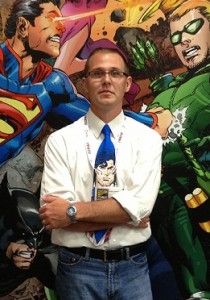 C&I’s researchers often travel the country and the world, visiting remote destinations to investigate issues and unique solutions to our most pressing challenges in education. This year, one Ph.D. student in the Art Education track, Jeremy Johnson, participated in a panel discussion at the San Diego Comic-Con, offering up findings on the potential of comics to increase student motivation and learning. We recently talked with Jeremy Johnson about his research and findings.
C&I’s researchers often travel the country and the world, visiting remote destinations to investigate issues and unique solutions to our most pressing challenges in education. This year, one Ph.D. student in the Art Education track, Jeremy Johnson, participated in a panel discussion at the San Diego Comic-Con, offering up findings on the potential of comics to increase student motivation and learning. We recently talked with Jeremy Johnson about his research and findings.
What fostered your passion for art education?
JJ: I was fortunate to have a fantastic art educator during middle and high school. He always encouraged his students to pursue their interests but also pushed us to reach our fullest potential. He helped me discover a passion for art. I initially went to college for a degree in graphic design and computer animation but after working as a graphic designer for a year, I realized that my calling was in the classroom, working with students.
What are you researching? Are there any preliminary findings you can share with us?
JJ: I spent five months earlier this year at a rural middle school in Western Wisconsin researching how the eighth grade reading and English teachers collaboratively designed an arts-based integrated Holocaust unit. The teachers taught the Holocaust by presenting survivor stories, having the students read non-fiction and realistic fiction novels and participating in a variety of other activities. This unit differed from previous years because instead of researching a Holocaust topic and writing a two page fact based report, the students were required to research a Holocaust topic and create a minimum six-page comic using the conventions of comics correctly. What made this unit unique is that comics were more than just the final project, they were built into the unit throughout so by the time the final project was assigned the students were familiar with terminology, how to design panels, draw figures and write a story.
At the beginning of the unit there was dread from some students while others became completely engaged and energized. One thing that stands out, now that I have begun to analyze all the information, is students who typically excelled or were labeled gifted and talented found themselves in a position that wasn’t comfortable to them; they struggled and therefore needed to put more time into their work. On the flip side, a group of students who previously struggled academically found this unit playing to their strengths: drawing and sharing stories.
For the first time all year, every student turned in the assignment on time, and many students admitted they developed a greater emotional connection to their topic because of the comic. Finally, the students presented their research-based comic at a community gathering. We were hoping to initially have about 200 parents, but that number swelled to over 400 attendants! Community members circulated through various classrooms viewing students’ projects and asking questions. It was well-received by students, parents and community members alike.
What gets you excited about your work? What really motivates you?
JJ: I am motivated by the prospect of promoting the idea of using comics as a valid instructional technique in classrooms. After seeing how many students in my research study were intrinsically motivated to produce high quality work, I think there is great potential for this in education and I want to share my ideas with other educators so that they can, in turn, share this with their students.
In what ways does the Department of Curriculum support you?
JJ: My department has been extremely supportive of my research. I have applied for the C&I travel grant the past two years, giving me the opportunity to travel to conferences to present my research and connect with a small group of other individuals interested in similar topics. The generosity of C&I has benefited my professional work immensely. I have been able to network with people in my field and have similar interests. The connections I have made have contributed and will continue to further improve my research and classroom instruction.
Tell us a little bit about you. What do you do in your free time?
JJ: My wife Lisa (currently a Ph.D. student in C&I’s Culture and Teaching track) and I live in Eau Claire, WI commuting daily to the University of Minnesota. At home we have five children: Nevaeh (8), McKail (6), Nadirah (4), McKellen (2) and Namarah (1). Much of our free time is spent doing activities together as family such as reading, doing art projects, gardening and volunteering at their school when possible.
When I do get some free time to myself I enjoy reading about comic theory aesthetics and my weekly stack of comics from the local comic book shop in Eau Claire.
For more information on Jeremy’s panel discussion, see the article, “Using Comics to Educate about the Holocaust,” and the Comic-Con Schedule.



